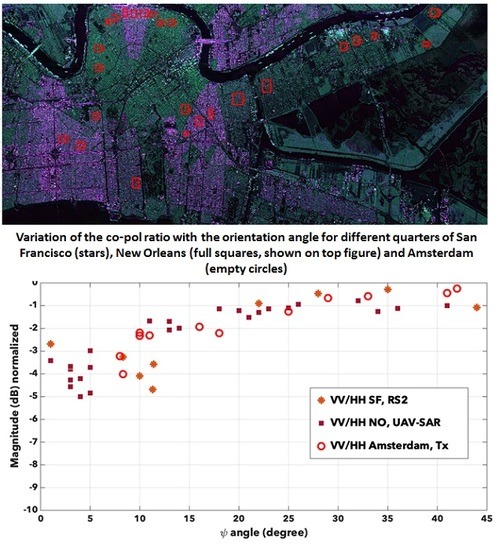The Combined Effect of Orientation Angle and Material on PolSAR Images of Urban Areas
Abstract
:1. Introduction
2. The Dielectric Dihedral and the Double Brewster’s Angle Effect
3. Methodology and Data Sets
3.1. Methodology
3.2. The Data Sets
4. Results and Analysis
4.1. Co-Pol Response
4.2. Cross-Pol Response
5. Discussion and Conclusions
Author Contributions
Funding
Conflicts of Interest
References
- Freeman, A.; Durden, S.L. A three-component scattering model for polarimetric SAR data. IEEE Trans. Geosci. Remote Sens. 1998, 36, 963–973. [Google Scholar] [CrossRef] [Green Version]
- Yamaguchi, Y.; Moriyama, T.; Ishido, M.; Yamada, H. Four-component scattering model for polarimetric SAR image decomposition. IEEE Trans. Geosci. Remote Sens. 2005, 43, 1699–1706. [Google Scholar] [CrossRef]
- Lee, J.S.; Ainsworth, T.L.; Wang, Y. Generalized polarimetric model-based decompositions using incoherent scattering models. IEEE Trans. Geosci. Remote Sens. 2014, 52, 2474–2491. [Google Scholar] [CrossRef]
- Singh, G.; Malik, R.; Mohanti, S.; Rathore, V.S.; Yamada, K.; Umemura, M.; Yamaguchi, Y. Seven-component scattering power decomposition of POLSAR Coherency matrix. IEEE Trans. Geosci. Remote Sens. 2019, 57, 8371–8382. [Google Scholar] [CrossRef]
- Hong, S.H.; Wdowinski, S. Double-Bounce Component in Cross-Polarimetric SAR From a New Scattering Target Decomposition. IEEE Trans. Geosci. Remote Sens. 2014, 52, 3039–3051. [Google Scholar] [CrossRef]
- Chen, S.; Ohki, M.; Shimada, M.; Sato, M. Deorientation Effect Investigation for Model-Based Decomposition Over Oriented Built-Up Areas. IEEE Geosci. Remote Sens. Lett. 2013, 10, 273–277. [Google Scholar] [CrossRef]
- Yamaguchi, Y.; Sato, A.; Boerner, W.M.; Sato, R.; Yamada, H. Four-Component Scattering Power Decomposition With Rotation of Coherency Matrix. IEEE Trans. Geosci. Remote Sens. 2011, 49, 2251–2258. [Google Scholar] [CrossRef]
- Guinvarc’h, R.; Thirion-Lefevre, L. Cross-Polarization Amplitudes of Obliquely Orientated Buildings With Application to Urban Areas. IEEE Geosci. Remote Sens. Lett. 2017, 14, 1913–1917. [Google Scholar] [CrossRef]
- Koeniguer, E.C.; Weissgerber, F.; Trouve, N.; Nicolas, J.; Onera, F. A new light on origins of polarimetric misclassification of the SoMa district due to the difficulty to predict entropy. In Proceedings of the POLINSAR, Frascati, Italy, 26–30 January 2015; pp. 1–5. [Google Scholar]
- Shang, F.; Huang, X.; Liu, H.; Hirose, A. Data Arrangement With Rotation Transformation for Fully Polarimetric Synthetic Aperture Radar. IEEE Geosci. Remote Sens. Lett. 2020, 17, 436–440. [Google Scholar] [CrossRef]
- Thirion-Lefevre, L.; Guinvarc’h, R. The Double Brewster Angle Effect. C.-R. Phys. 2018, 19, 43–53. [Google Scholar] [CrossRef]
- Azzam, R.M.A.; Ugbo, E.E. Contours of constant pseudo-Brewster angle in the complex ϵ plane and an analytical method for the determination of optical constants. Appl. Opt. 1989, 28, 5222–5228. [Google Scholar] [CrossRef] [PubMed]
- Le Toan, T.; Beaudoin, A.; Riom, J.; Guyon, D. Relating forest biomass to SAR data. IEEE Trans. Geosci. Remote Sens. 1992, 30, 403–411. [Google Scholar] [CrossRef]
- Di Simone, A.; Fuscaldo, W.; Millefiori, L.M.; Riccio, D.; Ruello, G.; Braca, P.; Willett, P. Analytical Models for the Electromagnetic Scattering From Isolated Targets in Bistatic Configuration: Geometrical Optics Solution. IEEE Trans. Geosci. Remote Sens. 2020, 58, 861–880. [Google Scholar] [CrossRef]
- Altair. FEKO™: A Comprehensive Computational Electromagnetics Code. Introduction. Available online: https://altairhyperworks.com/product/FEKO (accessed on 25 April 2020).
- Couderc, O.; Thirion-Lefevre, L.; Guinvarc’h, R. Analytical Solution for Permittivities of a Dihedral Configuration. IEEE Antennas Wirel. Propag. Lett. 2018, 17, 485–488. [Google Scholar] [CrossRef]
- Atwood, D.K.; Thirion-Lefevre, L. Polarimetric Phase and Implications for Urban Classification. IEEE Trans. Geosci. Remote Sens. 2018, 56, 1278–1289. [Google Scholar] [CrossRef]










| Center Frequency (GHz) | Incidence Angle | Range res. (*)/ Pix. Spacing (m) | Az. res. (*)/ Pix. Spacing (m) | City | Year | |
|---|---|---|---|---|---|---|
| RAMSES | 10 | 60° | 1.3 (*) | 1.4 (*) | Bretigny France | 1999 |
| UAVSAR | 1.2 | 30° | 5 | 7.2 | New Orleans USA | 2016 |
| RADARSAT-2 (FQ9) | 5.3 | 29° | 4.7 | 5.1 | San Francisco USA | 2008 |
| TerraSAR-X | 10 | 35° | 2 | 1 | Amsterdam The Netherlands | 2015 |
© 2020 by the authors. Licensee MDPI, Basel, Switzerland. This article is an open access article distributed under the terms and conditions of the Creative Commons Attribution (CC BY) license (http://creativecommons.org/licenses/by/4.0/).
Share and Cite
Thirion-Lefevre, L.; Guinvarc’h, R.; Colin-Koeniguer, E. The Combined Effect of Orientation Angle and Material on PolSAR Images of Urban Areas. Remote Sens. 2020, 12, 1632. https://doi.org/10.3390/rs12101632
Thirion-Lefevre L, Guinvarc’h R, Colin-Koeniguer E. The Combined Effect of Orientation Angle and Material on PolSAR Images of Urban Areas. Remote Sensing. 2020; 12(10):1632. https://doi.org/10.3390/rs12101632
Chicago/Turabian StyleThirion-Lefevre, Laetitia, Régis Guinvarc’h, and Elise Colin-Koeniguer. 2020. "The Combined Effect of Orientation Angle and Material on PolSAR Images of Urban Areas" Remote Sensing 12, no. 10: 1632. https://doi.org/10.3390/rs12101632
APA StyleThirion-Lefevre, L., Guinvarc’h, R., & Colin-Koeniguer, E. (2020). The Combined Effect of Orientation Angle and Material on PolSAR Images of Urban Areas. Remote Sensing, 12(10), 1632. https://doi.org/10.3390/rs12101632





